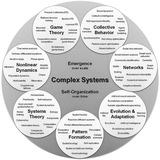#Netsci2020 will be an online-only conference! Check the announcement below for more details. Highlights:
- 5 days Conference from Sept 21st to Sept 25th
- A few weeks to amend your abstract or submit a new one
- we will host a special #COVID19 session
https://t.co/MtzUtrbwGe
- 5 days Conference from Sept 21st to Sept 25th
- A few weeks to amend your abstract or submit a new one
- we will host a special #COVID19 session
https://t.co/MtzUtrbwGe
Last few days (until June 5th) to submit your new abstract to #netsci2020 or to update your previous submissions. It will be a great online-only meeting, don't miss it! #netscisociety More info at https://t.co/HK6SM1Sqdf
Breaking news at #netsci2020: this year Euler Award has just been announced and it goes to Prof. Alessandro Vespignani!
https://t.co/j6njDNY7ye
https://t.co/j6njDNY7ye
📺 از سخنرانیهای ارائه شده در کنفرانس #netsci2020:
Efficient (limited time) reachability estimation in temporal networks
Arash Badie Modiri, Aalto University
How to measure extent of an spreading process from every possible starting point over a temporal network easily and efficiently? In this presentation we discuss an O(E Log E) method to do exactly that, using static event graphs and HyperLogLog cardinality estimator data structure.
📺 Video 🔗 Publication 🔗 Slides
Cite as:
Efficient (limited time) reachability estimation in temporal networks
Arash Badie Modiri, Aalto University
How to measure extent of an spreading process from every possible starting point over a temporal network easily and efficiently? In this presentation we discuss an O(E Log E) method to do exactly that, using static event graphs and HyperLogLog cardinality estimator data structure.
📺 Video 🔗 Publication 🔗 Slides
Cite as:
Badie-Modiri, A., Karsai, M., & Kivelä, M. (2020). Efficient limited-time reachability estimation in temporal networks. Physical Review E, 101(5), 052303.YouTube
Efficient (limited time) reachability estimation in temporal networks
How to measure extent of an spreading process from every possible starting point over a temporal network easily and efficiently? In this presentation we discuss an O(E Log E) method to do exactly that, using static event graphs and HyperLogLog cardinality…
